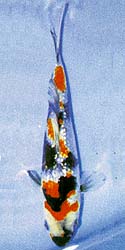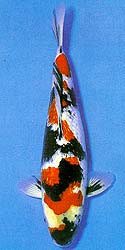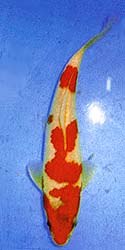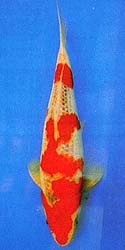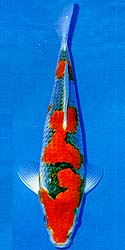"What's in a Bloodline?" Successfully selecting a young tategoi and watching it grow into its full potential is the often elusive goal of all koi keepers. Certainly, there are no guarantees where koi are concerned, but over the years I have found that the best insurance for a higher rate of success is to stick with the proven bloodlines. This means knowing where the koi came from and being aware of what that particular bloodline is capable of or prone to. Japanese koi breeders often specialize in varieties that thrive in their particular water, soil, and weather conditions, spending years establishing bloodlines that can be relied on to throw offspring that will develop in a fairly predictable manner. The city of Isawa in Yamanashi Prefecture is known for its hot springs and fertile but sandy soil. This combination of soil and water is said to be especially good for raising Showa and has prompted a number of koi breeders to locate their farms here, including Yuji Inoue of Ido Fish Farm. Mr. Inoue has established a line of Ginrin Showa with bold, lacquer-like sumi (black) that asserts itself early on in life. In the first photo when this Koi was just 5 months old and less than six inches long, we can see that both the sumi and hi (red) are extremely well defined for such a young fish.
Under the care of Mr. Masamichi Tatsuta of Tokyo, the Showa was raised to a little over 13 inches when it was entered to compete in the 26th All Japan Combined Nishikigoi Show. In the second photo which was taken at the show, we can see why it had no trouble taking First Place "A" Ginrin 35bu. The Goshiki featured here, was bred by Mr. Kuniyasu Hiroi of Oguriyama, Niigata, and raised by Mr. Katsuhiko Tashiro. "When selecting young Goshiki," says Mr. Hiroi, " I look for a those that have little or no sumi - the ones that look like Kohaku."
As Mr. Hiroi's Goshiki enter their second year, Asagi-like sumi begins to come up lightly in the white areas, as we can see in the second photo. By the time they reach their third year, the sumi begins to achieve an even balance with the hi. Our third photo features Mr Tashiro's Goshiki in all it's glory when it took First Place Goshiki 35bu in the 26th All Japan Combined Nishikigoi Show. The development of sumi in Goshiki is a relentless progression, sometimes quick and sometimes slow. It should be noted here that a lot of Goshiki tend to darken at an alarming rate when they are put into our hard water here in the United States, that not all bloodlines develop in the same fashion, and there are over twenty koi breeders bearing the surname "Hiroi" in Niigata.
BACK TO TOP |
||||||||||||||||||
|
|
||||||||||||||||||

